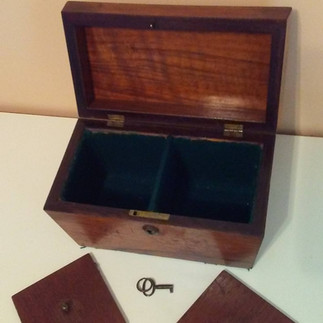A Mysterious Inheritance
- Lynne Christensen

- Apr 25, 2022
- 5 min read
Not Just a Wooden Box. History Lives Here.
You were thinking money, right? Of course you were. Did you know that many bequests are objects rather than money? In our family we have several wonderful heirloom pieces passed down through multiple generations. None of them are of great monetary value (no Picasso or Pollock paintings here), but they are treasured by our family due to the amazing history they quietly share, sitting in their places of honor. It’s important to preserve these wonderful treasures from the past. They may not hold a high auction hammer value, but to your family or the local archives they may well be worth their weight in gold.
The Family Heirloom: Tea Caddy
One of my favorite family heirlooms is a late-Georgian, Regency-era tea caddy passed down through our family from Grace Chowins, my great, great-grandmother. The Georgian era ran from 1714-1830 when four monarchs named "King George" succeeded to the throne of England. The Regency Era, one often referred to in romantic costume dramas, comes from the time when Prince George acted as regent for his father King George the Third during his time of illness and incapacity to rule from 1811-1820.
Not Just a Simple Wooden Box
The maker of our family’s tea caddy called it a ‘sarcophagus style’ unit, and it has two separate compartments for two different kinds of tea. It’s crafted from solid wood, likely rosewood. We still have the original key, and the box now houses costume jewelry and travel souvenirs. My grandmother lined it with green felt in the 1940s, presumably when she used a tin instead of this fancy wooden box for her own tea supply. I enjoy knowing that the box in our house today was once a vital part of a household 200 years ago. It’s a wonderful connection to the past.
Due to the exorbitant cost of tea in previous centuries, a tea caddy was kept locked and usually only accessed by the lady of the house. It’s definitely a far cry from whipping out a generic brand teabag from a grocery’s cardboard box and absentmindedly tossing it into a mug full of hot water. Yet, like many other objects and food now considered bland and every-day, tea and its accessories have a far more colorful history to revisit. Learning the history of an object, its contents and associated industry leads to a better understanding of its role in one’s own family history.
Learning the history of an object, its contents and associated industry leads to a better understanding of its role in one’s own family history.
Tea as a Luxury Item
When it was first imported from the Far East, tea was most definitely considered a luxury good for fine homes and polite company (note: this blog post does not provide a detailed history of the tea cultivation, harvesting, exporting and importing industries – entire books have been written on those subjects). When coffee houses opened in England mid seventeenth-century, they were popular places for men—women were not allowed—to socialize, gossip and discuss news. Near the end of 1650, Chinese tea was sold at coffee houses; early dealers made revenues around ten pounds currency per pound of tea! Tea was mainly consumed in upper class homes, with numerous ladies enjoying an elegant tea service ritual that male-only coffee houses did not permit. Of course, government and the king soon caught onto tea’s popularity and taxes on the luxury good appeared.
Tea as a Smuggled Good and a Political Statement
Smuggling in the English county of Cornwall was all too frequent in centuries past. Ever heard the term, "the coast is clear"? It derives from an old smuggler’s ritual of surveying the land for customs officers before he anchored to unload a vessel full of contraband. All items subject to high duties were on the smugglers’ list; they included tea, lace, salt, velvet and alcohol coming in tax-free from the European continent. Cornwall, situated at the tip of south west England, has a rich smuggling history. Cornish houses had secret trapdoors, window wells and storage under dining room tables to conceal large hoards of illicit goods. Sometimes well over a hundred people would be summoned down the cliffs to help unload a vessel anchored in a quiet bay. Smuggled goods were rowed ashore in small boats, and long lines of ponies were used to help transport them to hiding spaces in the nearest town before distribution further inland. Women were sometimes employed to carry jugs of whiskey underneath their large skirts as they were seen as safe from a custom officer’s search. There were some violent skirmishes between the customs officers and smugglers. Customs officers were far outnumbered and some were even on the take. Local vicars were known to turn a blind eye to the smuggling activity so long as they received a secret container or two of brandy well-hidden on their back doorstep!
Predictably, when the extreme taxes were reduced in the later eighteenth-century, tea smuggling ceased as it was no longer profitable. Yet, tea’s impact on history wasn’t finished. Tea was the valuable commodity used to resist "taxation without representation" at the history-making Boston Tea Party in 1773. Hundreds of chests of valuable tea were dumped into the seawater in protest and this event is often marked as a momentous step towards American Independence. Tea’s historical timeline continues with further industry and marketing developments including tearooms, iced tea, the teabag, tea breaks and instant tea. It’s a product steeped into our culture and shows no signs of abatement.
Conclusion
The next time you drink a cup of tea, make sure to consider its history. Tea’s history encompasses world trade and memorable events, creating quite a story for a product that many of us see today as a humble teabag. Companies around the world now produce umpteen varieties, with and without caffeine, in hundreds of flavors, blends and strengths. The product is available with same day, free delivery; no doubt something the olden day smuggler would have cast aside with disbelief. Tea is still what the stalwart British yearn for after a hard day; "let’s put the kettle on, dear" was always a frequent refrain in our home and in those of our ancestors. Imagine how much fun it is to share the story of our tea caddy with family and friends; the quiet wooden box on the shelf now gets more than a mere passing glance.
I encourage everyone to share their own stories about treasured heirlooms and document this heritage for future generations. You’ll learn some amazing family history in the process.
References:
Mortimer, I; "The Time Traveller’s Guide to Restoration Britain", Penguin Random House UK, published 2017, P284-286.
Timeline: "A story of tea": https://www.earthstoriez.com/tea-timeline/, sourced April 20, 2022.










Comments